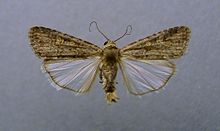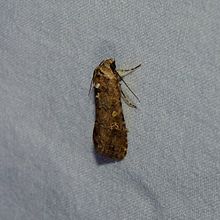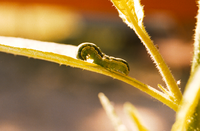- Beet armyworm
-
beet armyworm 

Scientific classification Kingdom: Animalia Phylum: Arthropoda Class: Insecta Order: Lepidoptera Family: Noctuidae Genus: Spodoptera Species: S. exigua Binomial name Spodoptera exigua
(Hübner, 1808)Synonyms - Noctua exigua Hubner, 1808
- Caradrina venosa Butler, 1880
- Laphygma exigua
The Beet Armyworm or Small Mottled Willow Moth (Spodoptera exigua) is one of the best-known agricultural pest insects. It is also known as the asparagus fern caterpillar, and the adult moth is known in the UK (where it is an introduced specie and not known to breed) as the small mottled willow. It is native to Asia, but has been introduced worldwide and is now found almost anywhere its many host crops are grown. The voracious larvae are the main culprits. They are greenish-brown cutworms, soft and bulging caterpillars with dark longitudinal stripes. The adult is a drab brown or gray moth 2 to 3 cm in wingspan.
The larvae feed on the foliage of plants, and can completely defoliate small ones. Smaller larvae devour the parenchyma of leaves, so that all that remains is the thin epidermis and veins. Larger larvae tend to burrow holes through thick areas of plants. For example, they will burrow straight into a head of lettuce rather than neatly removing tissue from one particular leaf. This renders the produce unmarketable. They attack buds and new growth on plants, preventing flowers from opening, new leaves from sprouting, and vegetables from developing. As the smaller larvae move about they leave strands of silk behind, netting the leaves with a silvery film.
Illustration
The wide host range of the beet armyworm includes asparagus, beans and peas, sugar and table beets, celery, cole crops, lettuce, potato, tomato, cotton, cereals, oilseeds, tobacco, many flowers, and a multitude of weed species. The beet armyworm does not tolerate cold. It can overwinter in warm areas, such as Florida and Hawaii, but in colder areas it dies off during the winter and the region is reinvaded by the adult moth as the weather warms and crop plants sprout.
External links
- beet armyworm video Spodoptera exigua, a migratory plague.
- beet armyworm on the UF / IFAS Featured Creatures Web site

This Hadeninae-related article is a stub. You can help Wikipedia by expanding it.

